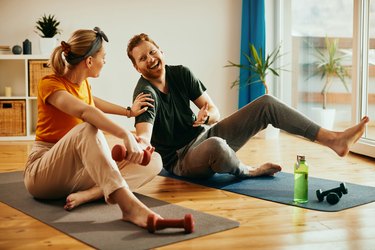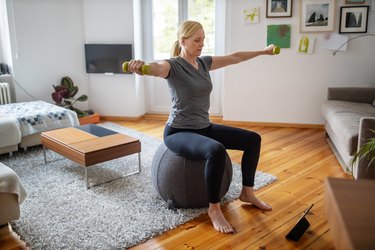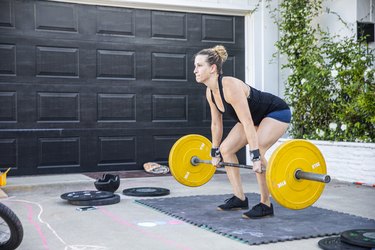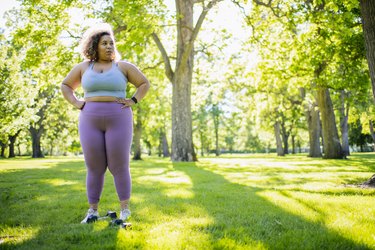
One of the best parts about strength training? There's no one perfect way to do an exercise. Sure, you want to move with good form. But different exercises look a little different for each person — after all, no two bodies are exactly alike.
And that's how it should be. Everyone's body moves differently and we all have our own unique strengths and weaknesses, explains Morit Summers, CPT, a certified personal trainer and creator of Brooklyn-based training studio Form Fitness.
Video of the Day
Video of the Day
But prioritizing compound movements — exercises that move multiple joints at once — is ideal for most people starting out. Rep per rep, these moves most effectively build total-body strength, mobility and health.
Each week, doing a push, pull, squat, hip hinge (deadlift) and carry exercise is a great way to ensure you're taking the best care of your fitness and body, says Samuel Becourtney PT, a physical therapist at Bespoke Treatments in New York City.
And remember, while these fundamental exercises (like the moves below) are beneficial for bodies of all shapes and sizes, adjusting moves to fit your needs is the key to success when you're starting out.
Every single exercise has a progression, regression and hundreds of variations, Summers says. For instance, beginners with bigger bodies can modify an air squat, a popular beginner strength exercise, by widening their stance. This gives your legs and stomach a little extra room to move.
Also, remember that no matter the exercise you're doing, one simple way to modify it is by increasing or decreasing the weight of the dumbbells (or other tools) you use. As you choose different weights, take your own body weight into account. With moves like a squat or deadlift, you lift not only the weight you're gripping, but also the weight on your frame.
A good general rule: Select a pair of weights that feels really comfortable to lift and maneuver at first. Focus 100 percent on movement and form, testing modifications as needed. (You'll find plenty of those below.) Then, when you can do all your moves for 8 to 10 reps of 3 to 4 sets with ease, grab a heavier weight.
Got your dumbbells? Here, Summers demonstrates the five best strength exercisers for beginners living with obesity.
Move 1: Chest Press
Although this move focuses on your chest, it also hits your shoulders, triceps and all-important core, Becourtney says. It teaches all of these muscles to work together, and is a great way for people with heavy bodies to work up to push-up variations.
As you do this one, focus on keeping your feet firmly planted on the ground, your back flush against the floor.
FYI, some people opt for doing chest presses on a bench. But lying on the floor, rather than a bench, can be more comfortable and stable for some plus-sized lifters. Do what feels best to you.
Chest Press
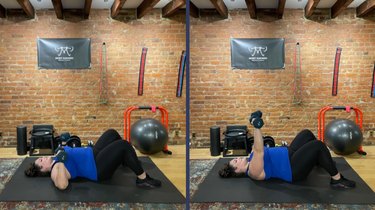
- Lie on your back on a weight bench (or the floor) with a dumbbell in each hand. Hold the weights with straight arms above your chest. Plant your feet firmly on the floor and tighten your abs.
- Bend your elbows and lower the weights until they are in line with your chest.
- Pause, then press the weights back up over your chest.
2. Dumbbell Bent-Over Row
This move targets the muscles in your back that support your spine — making it especially helpful for beginners with obesity or large breasts who may experience back pain or discomfort.
This dumbbell row variation is a great alternative to the bench-supported row (in which you lie face-down on a bench) for anyone with a large stomach or breasts.
Do this exercise to improve your posture, boost your upper-body strength and train for your first pull-up.
Dumbbell Bent-Over Row
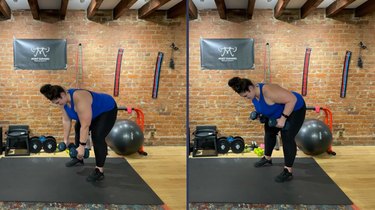
- Stand with your feet between hip- and shoulder-width apart and hold a dumbbell in each hand in front of your thighs. Shoot your hips back and hinge forward at least 45 degrees (and up to 90 degrees), keeping your back flat. Start with your arms extended toward the ground, palms facing each other.
- Squeeze your shoulder blades down and together, then draw your elbows up toward your ribs to pull the weights up alongside your lower abdomen.
- Pause, then lower back down to the start with control.
Tip
Focus on keeping your hips back and back flat during this exercise. It will help keep your back comfortable. Feel free to take breaks and come back to standing as needed to maintain good form.
To make this move a little easier, use only one weight and place your free hand on a bench for extra stability.
Move 3: Goblet Squat
Whenever you get up out of a chair or sit down onto the toilet, you're doing a squat and working your quads, glutes and hamstrings, Becourtney says. You use the squat movement pattern in so many activities (both in and out of the gym), it's perhaps the most important strength exercise for beginners to learn.
Some athletes with bigger bodies like to take a wider stance to make squats feel more comfortable. This gives your legs and stomach a little more space while working the same muscles.
Goblet Squat
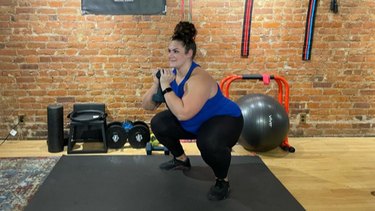
- Hold a dumbbell by one end at chest-height.
- Begin with your feet between hip- and shoulder-width apart. (Your toes can face forward or turn out slightly.)
- Keeping your chest tall and core tight, hinge your hips back and down to sink into a squat so your upper legs are parallel with the floor (or as low as you can comfortably go with good form).
- Press through all four corners of your feet to return to standing.
Move 4: Dumbbell Deadlift
Deadlifts are great for everyone because they build your body's biggest, most powerful muscles. They also teach you how to lift with your legs and not your back, Becourtney says.
When getting started, opt for dumbbell deadlifts. Whereas tools like the barbell stay in a fixed position, dumbbells allow you to hold your shoulders and arms in the way that's most comfortable for your anatomy.
When you get back into a hip hinge (the bottom of the deadlift), it's totally OK for your thighs and abdomen to touch. But if you feel it's limiting you from really lowering into the exercise, go ahead and step your feet out wider.
If it still doesn't feel great, try a sumo deadlift in which your feet are more than shoulder-width apart and your arms hang in between.
Dumbbell Deadlift
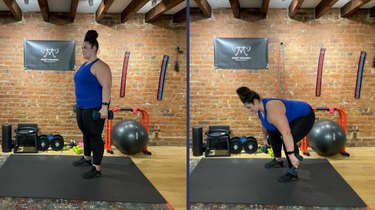
- Stand with your feet hip-width apart holding a dumbbell in each hand in front of your thighs, palms facing your body.
- Hinge from the hips, softening your knees as your hips sink enough to lower the weights toward the middle of your shins.
- Check your posture: Your spine should be straight and long, chest up and open, shoulders back.
- Engage all the muscles of your core to maintain this position as you push your feet into the floor, as if you were trying to push the floor away from you using your glutes and hamstrings, to pull the weights up and return to standing.
- Reverse the motion to lower the weights with control and repeat.
Move 5: Farmer's Walk
Have you ever carried a bag of groceries in each hand? Then you've done a farmer's walk.
This total-body strength move is super functional, strengthening your body for the tasks you probably do every day, Becourtney says. And you can expect a surprisingly big core burn. It's actually one of the best core exercises for beginners (and lifting veterans) out there.
Once you've mastered the fundamental move, you try variations like the suitcase carry in which you hold a single dumbbell in one hand. (It really zones in on your obliques!)
Farmer's Walk
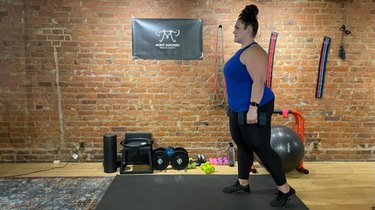
- Hold a dumbbell in each hand (or one on one side). Choose a weight that's heavy enough to challenge you yet light enough that you can maintain good posture while walking.
- Engage your core, pull your shoulder blades down and back and stand tall.
- Take a step forward and begin walking. Walk forward while keeping your spine tall, shoulders back and head up.
- Continue walking movement for a specified time or number of steps.


